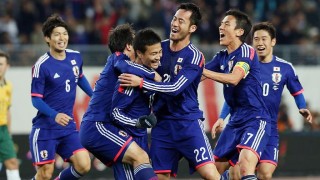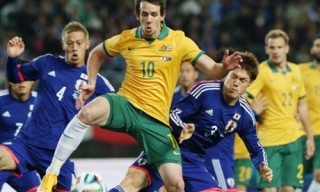Loading
Search
▼ Australia v Japan: five things we learned
- Category:Other

THE GUARDIAN
Fox Sports’ pundit Mark Bosnich described the Socceroos’ first half performance against Japan as the most promising football he had seen since the Ecuador game. In that game, Australia took a 3-0 lead into half-time only to be pinned back in the second half, losing 4-3 after being reduced to 10-men early in the second half. It’s not the first time the Socceroos have failed to play out a consistent 90 minute display. In the past 12 months, Australia have performed in patches – 20 minutes here, 60 minutes there. At the World Cup, 45 minutes of dominance against the Dutch and 70 minutes of quality football against Chile was enough for the fans to being positive about steps being taken but, increasingly, these patches have been not enough to outweigh the negatives of losing.
After the defeat to Japan, “We were excellent first half and then, to begin the second half, I thought we looked comfortable but we conceded that goal and that gave them the momentum and we lost a little bit of belief,” said coach Ange Postecoglou, who will have to continue to use all his managerial nous and experience to ensure the Socceroos are ready come 9 January.
Where was the man at the back post? And who was supposed to be marking Yasuyuki Konno as he peeled away from the pack to head home Keisuke Honda’s corner unopposed? Australia hadn’t defended set pieces well all night and fell behind after, once again, a lapse in concentration without the ball.
Australia has been plagued by these costly errors. In the past, Australia’s inability to hold a consistent high line has been an issue. The failure of one defender to step out with the rest of the back four has often kept opposition attackers onside as they move into the box to finish off moves. Jason Davidson against the Netherlands, Davidson, again, against Spain and more recently Alex Wilkinson against Qatar have been just a fraction too slow. But that is all opponents need to be kept onside and Australia has been made to pay.

Against Japan, Australia kept a consistent back line and, even though they were helped by the linesman in the first half, they didn’t suffer from the same defensive issue. But it was the lapse in concentration at a set piece that proved to be just as costly.
“We played as a 4-3-3 in the Middle East,” said Ange Postecoglou in the build up to the Japan game, “and that’s probably why we weren’t as fluid because we changed the system and played with just the one holding midfielder. Changing to a 4-3-3 was always going to be part of the evolution of the team ... In the Middle East, when we played with only the one holding midfielder, that’s certainly what we’ll be doing going into the Asian Cup.”
The Socceroos had briefly experimented with the 4-3-3 formation in their 1-1 draw with South Africa in May but Postecoglou turned back to the formation in the matches against Qatar and United Arab Emirates. With a recognised holding midfielder in Mile Jedinak and an abundance of mobile, box-to-box players, the 4-3-3 formation suits the current playing squad which does not have a natural, creative attacking playmaker. One of those more mobile players is Melbourne City’s Aaron Mooy, who came off the bench to become the 42nd player used during his reign as manager. Of those 42 players, some are no longer in the picture of national team selection, but Postecoglou has created a large pool of players who have been exposed to his training and playing methods and who have now all been exposed to international football. That is a positive step in the regeneration of the Socceroos. But the next step, the Asian Cup in January, is about nailing down a strong 23-man squad from Postecoglou’s pool of 40-50 players.
Few would have expected Australia to dominate possession and the proceedings in the first half against Japan. But a tactical and personnel change at half time allowed the hosts to improve and shine in the second half.
Japan had started as a 4-3-3, with Makoto Hasebe as the only holding midfielder. But a deeper than anticipated defensive block and the movements of Australia’s wingers, who moved inside when in possession, saw Hasebe overwhelmed. Javier Aguirre changed formation at half-time, with Yasuhito Endo making way for Konno who moved into a second holding midfielder role next to Hasebe.
That freed up Shinji Kagawa and Japan to pressure higher up the pitch and limit Australia’s possession. The swap proved effective and Japan quickly established their dominance. Not only because they were able to react tactically, Japan’s technical superiority also allowed them to turn the screws on Australia. Shinji Okazaki’s sublime finish to put Japan 2-0 up was an example of that technical ability, while behind Okazaki, Honda and Kagawa pulled the creative strings.
Australia are still reliant on Tim Cahill for goals. Twelve months to the day since Postecoglou’s first game in charge against Costa Rica, Cahill remains the only Australian to score from open play. It’s a worrying statistic and one that needs rectifying. Australia need a variety of attacking threats to avoid being one dimensional, a label that could be placed on the side given their reliance on Cahill’s forehead.
Australia had started the Japan game with Cahill on the bench and Mathew Leckie playing as the central striker in a 4-3-3. James Troisi and Robbie Kruse flanked Leckie, but when Australia had possession, both wingers took up narrow positions in between Japan’s line of defence and midfield. This allowed Australia to create overloads in the centre of midfield but once again that crucial final pass and/or finish was lacking.
In the absence of goals elsewhere, Australia will have to rely on Cahill for a little while longer. Perhaps a future strike pairing of Tomi Juric and Kerem Bulut will be the solution to all Australia’s woes? We can all dream.
- November 20, 2014
- Comment (0)
- Trackback(0)

